Here is the Volume 1 of American Football from When you watch something, visit us first! Mr. Yorihisa SEKIGUCHI, former Head Coach of the “ThreeNailsCrowns “, the American Football team of J.F.Oberlin University told us about what happens in that “mess” during American Football matches. This is the complete version of Part 1-1 and 1-2 on our YouTube channel.
When you watch American football games, you will often see scenes like these. What are the aim of players and teams?
Mr. Yorihisa SEKIGUCHI, former Head Coach of “Three Nails Crowns” which is the American Football team of J. F. Oberlin University, and who has served on the coaching staffs of a number of prestigious American Football teams, told us the aim of them.
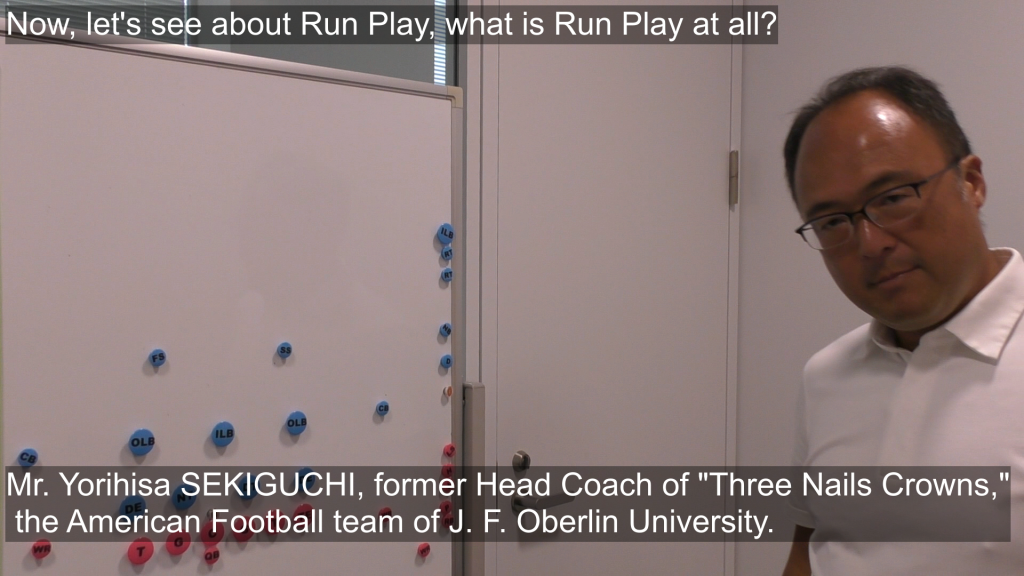
Part1-1: What happens in that “mess” (Run Play)
Now, let’s see about Run Play, what is Run Play at all?
Basically, in Run Plays, either Quarter Back (QB), Full Back (FB), or Running Back (RB) carrys the ball and plays the ground battle. To run with the ball he receives from Center(C) by QB himself, or to hand it to FB or Tail Back (TB) to run on various courses are the basis of Run Play.
The main ball carrier is RB. Especially to run with the ball, RB is in charge with the specialty. On many teams, I think that RB will have the ball in about 80% of Run Plays.
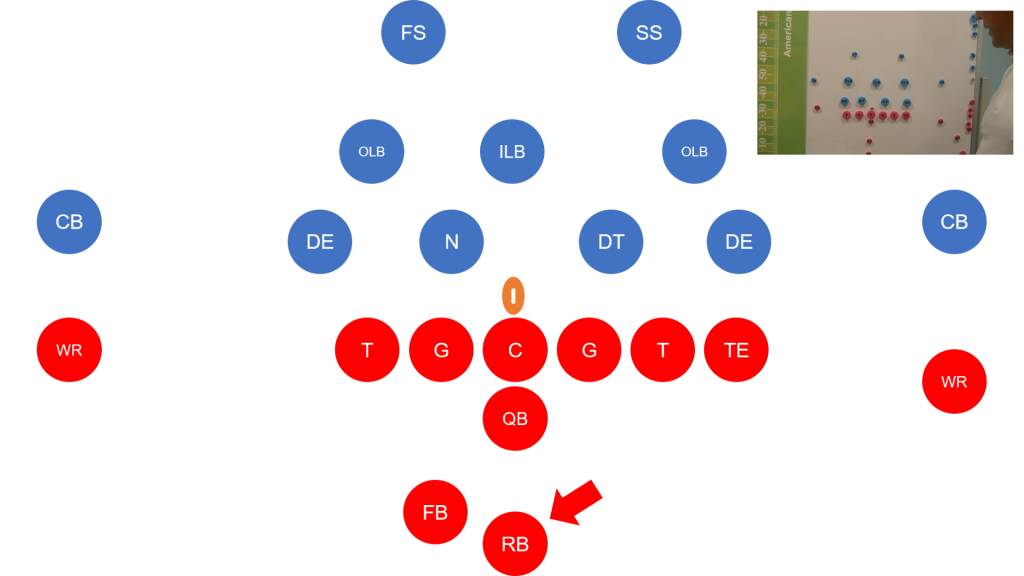
I will now explain a typical Run Play. Let me explain a typical Run Play called “Power.” This “Power” is played all over the world, and when people talk about “Power” in both the United States and Japan, they are referring to this play.
I will now explain “Power” from I formation. “Power” can be played in many different formations, but it is the most orthodox form. Against this DT (Defensive Tackle), both (Right) Guard (G) and (Right) Tackle (T) push him backward. C pushes this player (Nose Tackle=NT) alone. TE (Tight End) leaves his original position to block this Inside Line Backer (ILB). And FB “kicks this player (Defensive End=DE) out” (=block toward outside).
Then a runway will be created here.
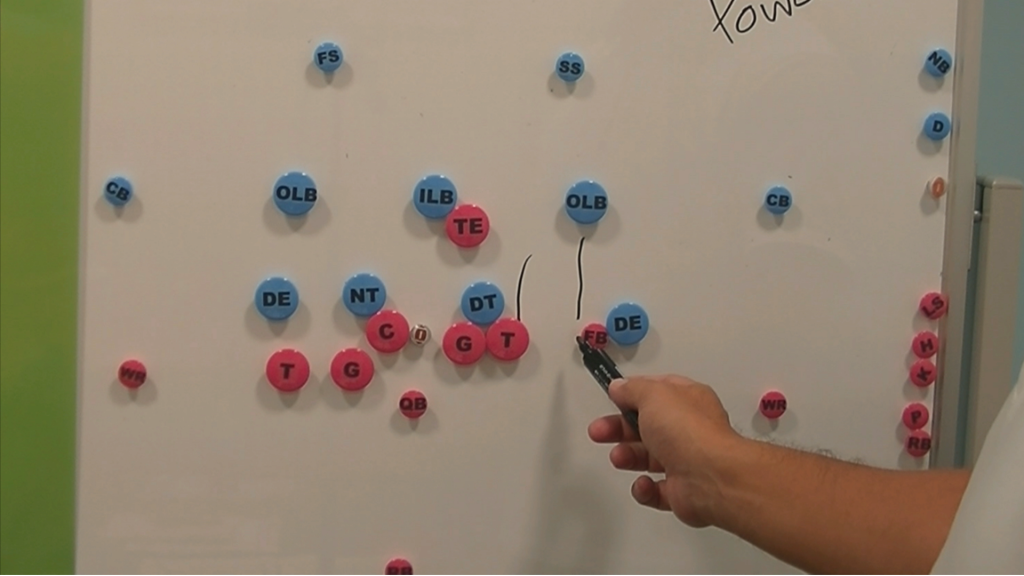
A play to make RB to run the outside of the T like this manner is called “power”. Most of “Power” plays, G of the opposite side comes to this runway to block this person (Outside Line Backer=OLB). QB hands the ball to RB coming here and this RB runs just by these two blocking players. This is the basis of the “Power” play.
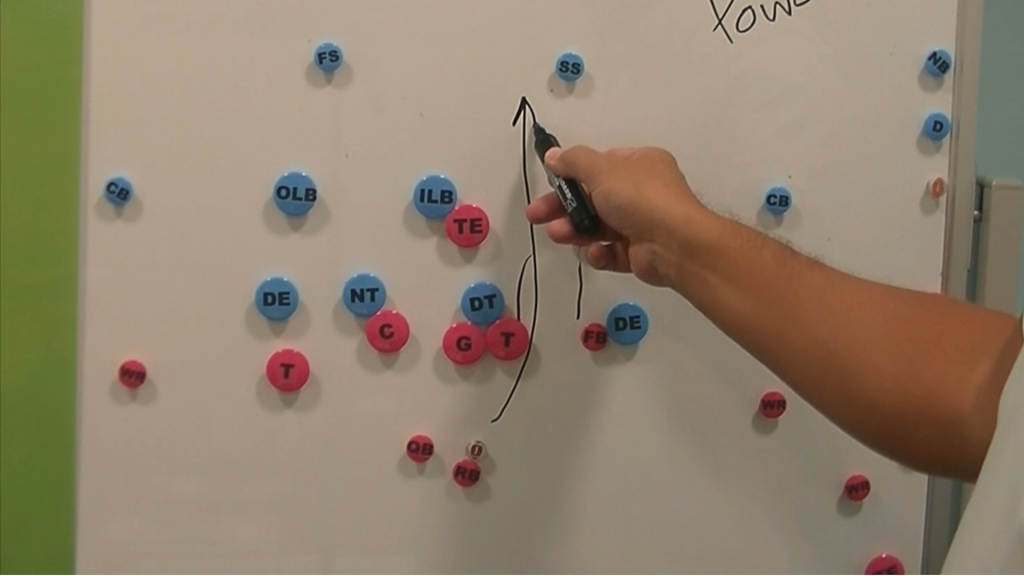
What I just described is generally called “Power.” A scheme such as it is decided who blocks who for defensive formation and where RB is to run, is called “Gap Scheme.”
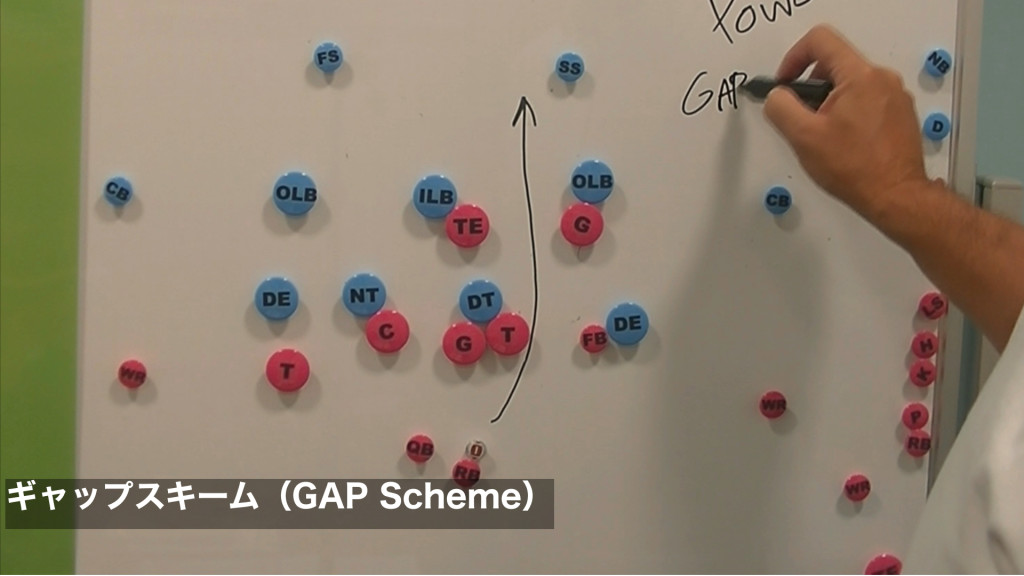
Here is another scheme “Zone” that are different from Gap Scheme mentioned earlier. Since there are two types of “Zone”: “Inside Zone” and “Outside Zone”, I will now explain about “Inside Zone.”
“Zone” is essentially a “block an area” scheme. It means, when “to do the right side Zone,” each player blocks the area of his right side. T blocks here. G blocks the opponent who comes here. They protect the gap next to themselves.
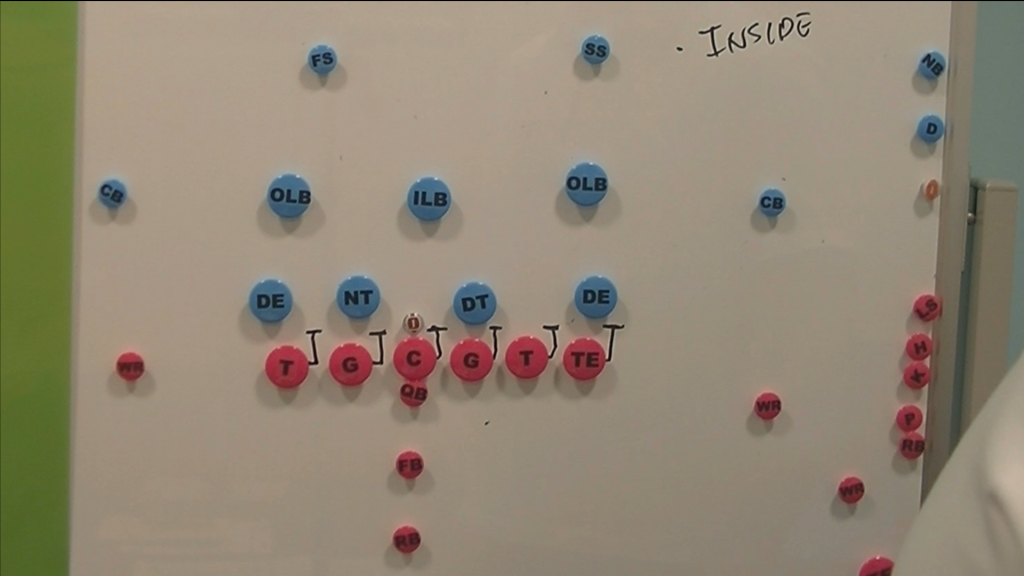
If this player (OLB) comes here, TE blocks him. If this player (DT) comes here, G blocks him. If this player (DT) comes here, and so on. In this way, it is to block like this if defense players charge.
Then, RB handed the ball from QB looks for where the runway could be made, while he is around here. Usually, they do not line up neatly like this.
For example, if the situation is “He is pushing in there,” “They are blocking well there,” and “he is also holding well there,” RB thinks “perhaps a runway would be made there.” Then, RB can run through “A Gap” (Gap next to C.)
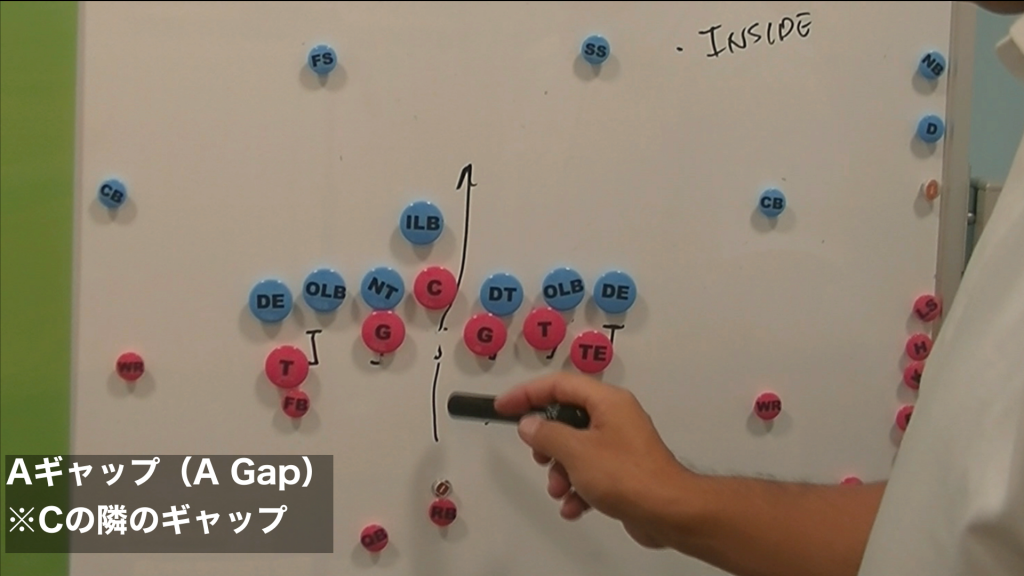
Or, if they all seem to line up nicely like this, they are all blocking neatly, but “he is blocking like this and pushing in there,” or “he is also pushing in quite a bit there,” then the RB can run this route.
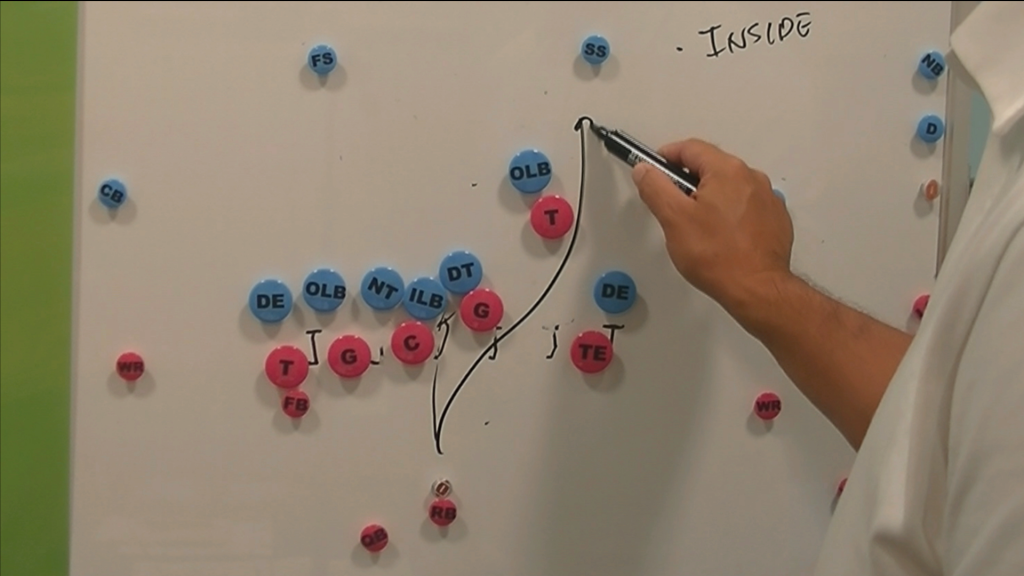
Although RB has been ordered where he will run roughly in advance, RB will make the final decision on where he will run while watching the block situation. This is “Zone” play. And, the play in which RB runs through “Tackle Box” (between the left T and the right T) is called “Inside Zone” and the play in which RB runs outside of it is called “Outside Zone”.
Therefore, in this play, each player is decided where to block, not to block “who” but “which area,” and then the ball carrier decides the course to run while watching where the space will likely be made. This is the concept of “Zone”.
The role of Offensive Line (OL) and TE in Run Play is, for OL who to block is generally decided, although it depends on the defensive formation, to make a space at the certain course. To push in their assigned opponents anyway to keep RB carrying the ball from being tackled, to push, to push, is their mission.
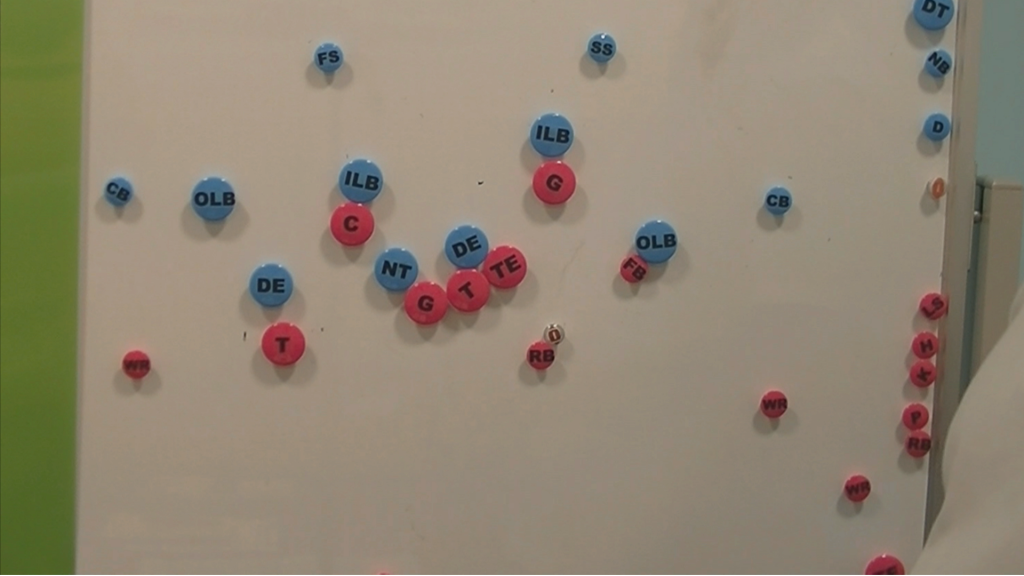
It may look like a mess, but they are assigned clear roles. In Gap Scheme, “who blocks who,” and in Zone, “who stops the opponent coming to which area” are determined.
And to clear a path with giving their all for RB to run, or for the opponent coming to their assigned area, so that the opponent will not tackle RB is the roles of OL and TE in Run Play.
Part1-2: What happens in that “mess” (Pass Play)
Now, let me explain about what these people are doing during Pass Play.
In Pass Plays, QB who receives the ball from Center (C) drops back a little. If he stays here, defensive players around this area will raise their arms to block his pass, so he will step back a little after he receives the ball. Wide Receiver (WR) runs a preset yardages first and then turn around, turn outside, or run a farther long distance, which is a predetermined route called Pass Route.
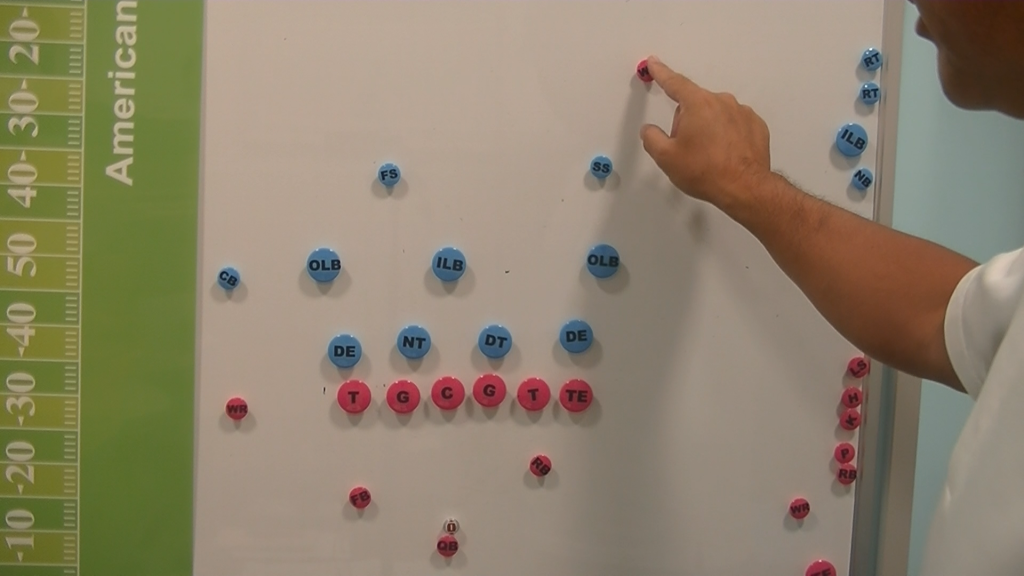
And, QB who has the ball must wait until WR reaches there.
The main role of the 5 players called Offensive Line (OL) in Pass Plays is, against the defensive players, especially players of Defensive Line (DL), who come to tackle QB before he throws a pass, to protect QB by blocking them.
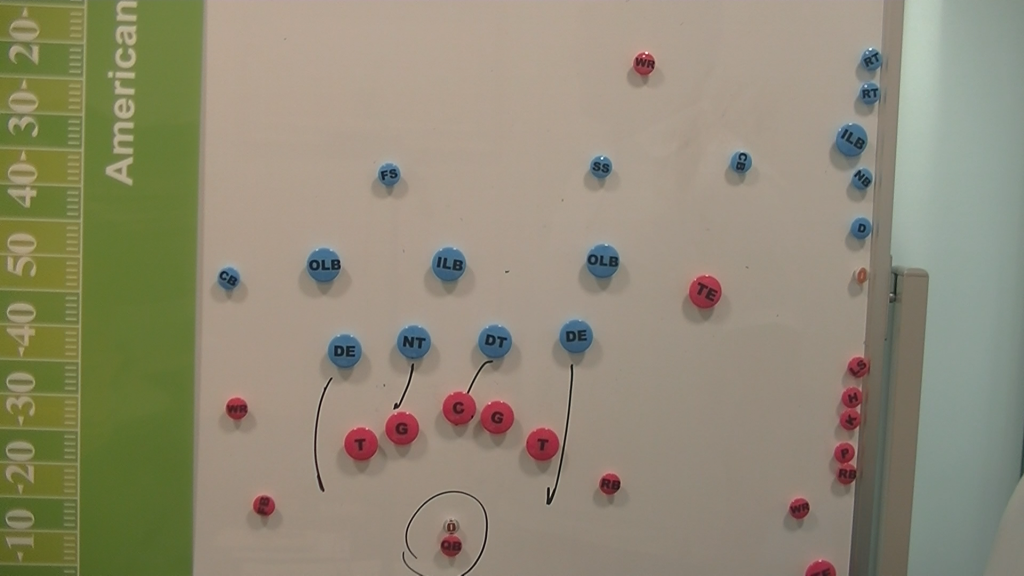
In many cases, a pass is thrown within 2 to 3 seconds. At 3 seconds or more, QB is likely caught, and at 4 seconds or more, QB is almost always caught by these players. Therefore, to give QB 3 to 4 seconds, or even more time if possible, is the role of OL on Pass Play.

Of course, defensive players are not stupid, so they do not come to the same way every time.
For defensive players, a QB sack is a kind of a medal, so they want to sack and crush QB by anyway. Then, what they do is to cross each other, for example. After Defensive End (DE) comes this way, this player enters the space opened. This way of rushing is commonly called “EAT” because End and Tackle cross each other. “EAT” means “End And Tackle.”
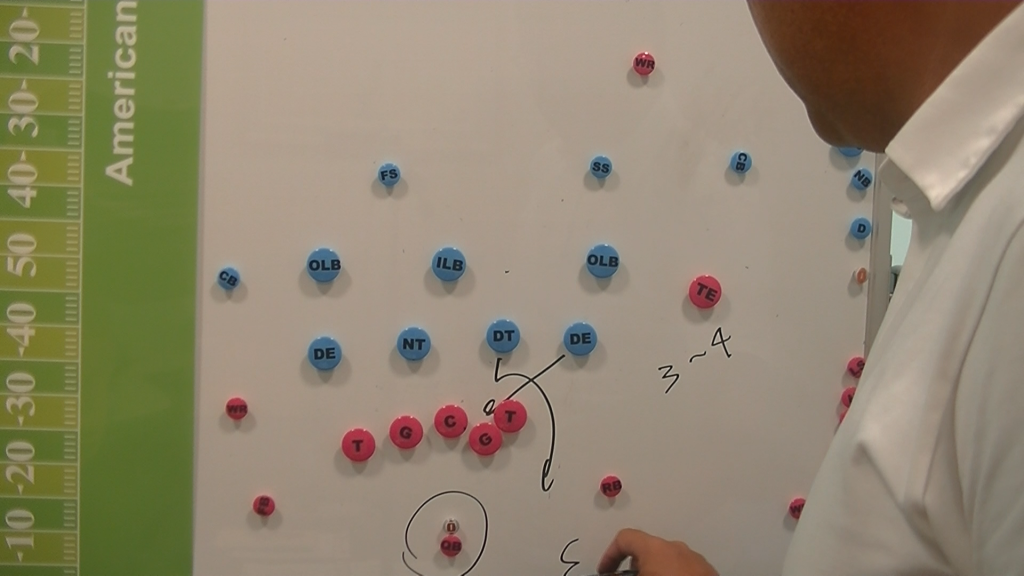
There is also reverse way, for example, DT comes to this way first, and then DE enters this space. This way is called TEX. “TEX” means “Tackle End Cross(X).”
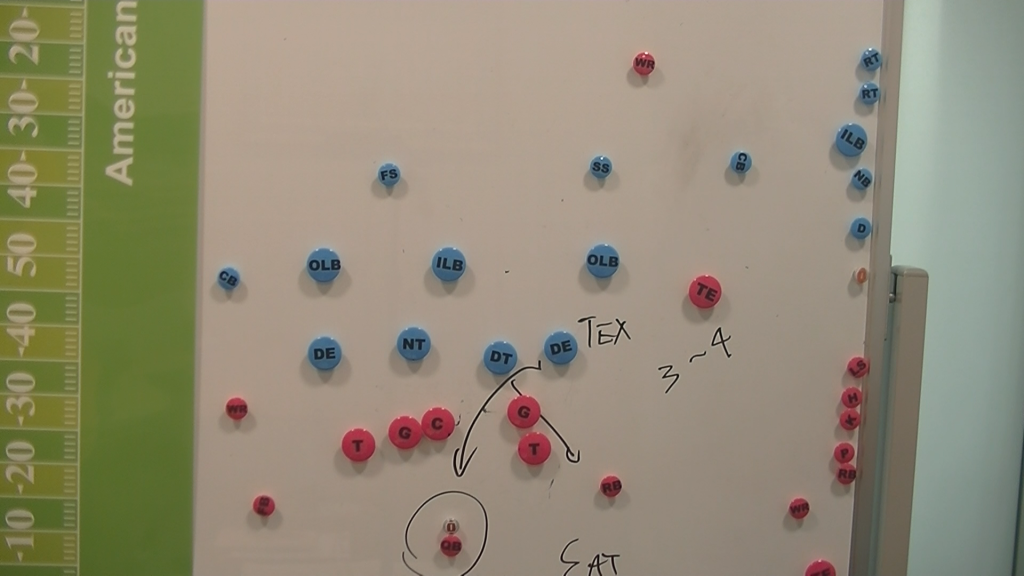
Like this, the way of rushing with DL players cross each other is called “Stunts”. Defense sometimes uses Stunts.
Or, if Defense think that only by Stunts, they cannot block QB throws a pass, and they want to sack QB more reliably, then, all DL players will move in this way, and this player will rush into the open space. A Pass Rush by someone other than DL is called “Blitz.” To try to get a QB sack using Stunts and Blitz is what Defense often does.
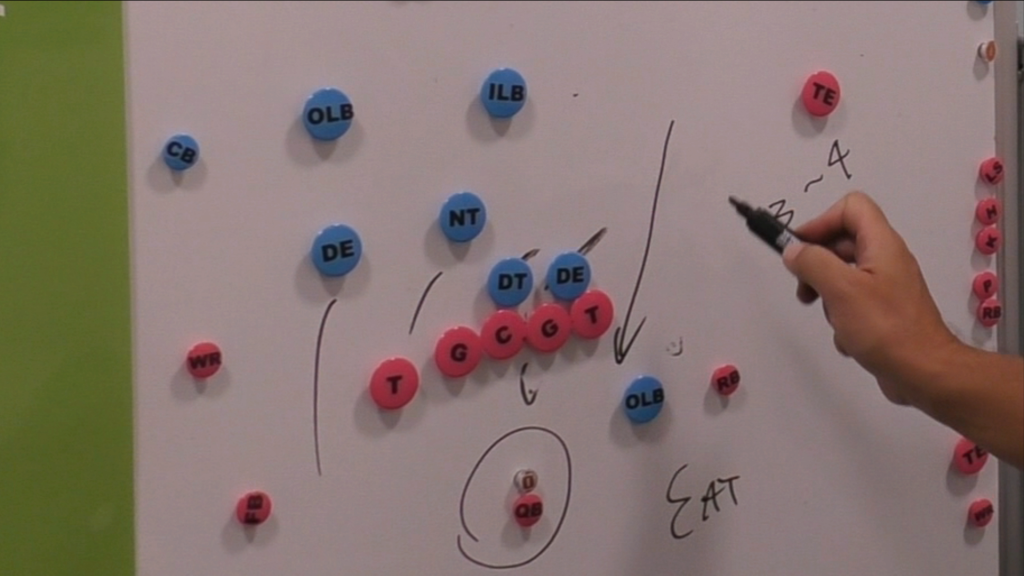
OL players strive to prevent their QB from being tackled anyway. Even if DL move this way, he would think “I won’t be tricked,” and would stay here and block him. This is called “Protection.” And this shape is called “Cup” because they protect QB in a formation like a beautiful cup. Like this, there are blocking players against rushing players, which always happens on every Pass Plays.
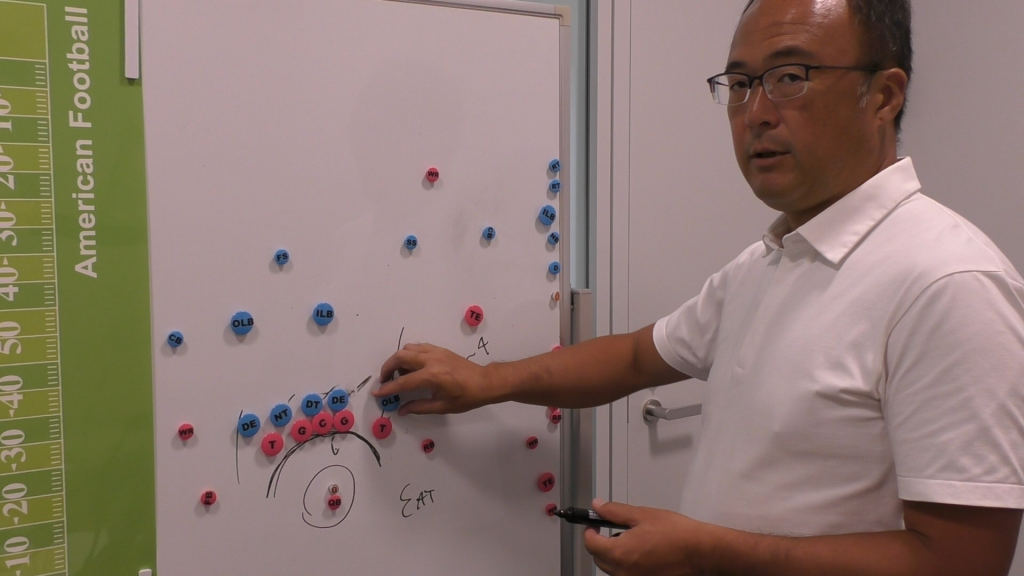
Protection techniques in Pass Play are basically the same. However, it varies from position to position, with the inside generally being 2-on-3 like this and the outside often being 1-on-1, and the techniques for blocking fast players on the outside and those for blocking heavy players on the inside are different. They practice these techniques everyday.
On the other hand, defensive players may spin around during a Pass Rush
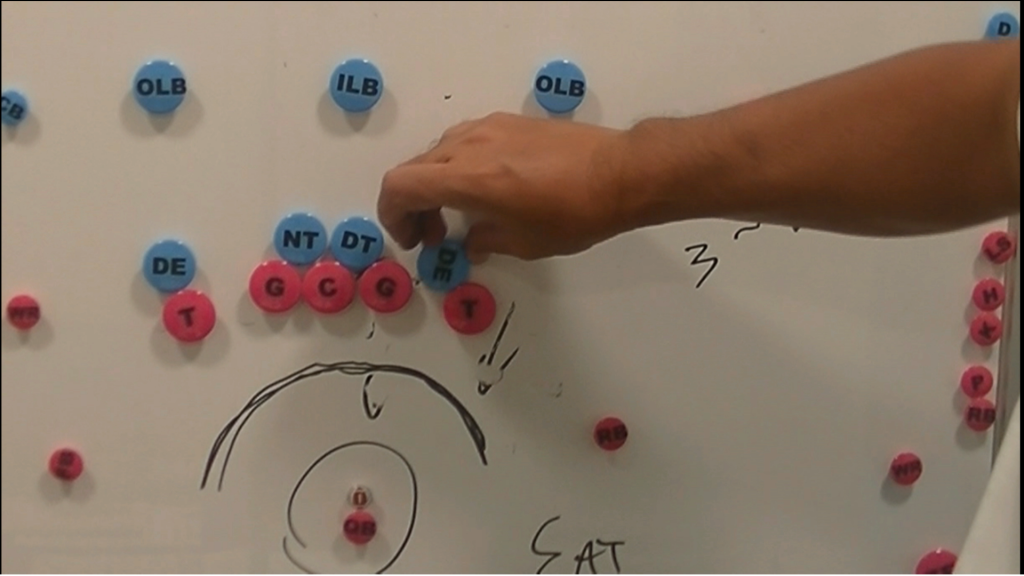
or use their arms to break the opponent balance. There are many Pass Rushing techniques. They also practice these techniques everyday. Therefore, I don’t think any player is going against the opponent without taking any measures.
Especially at the professional level, they use various techniques to rush, such as slapping the opponent’s arms here, or spinning as I mentioned earlier. It may look something like a mess,
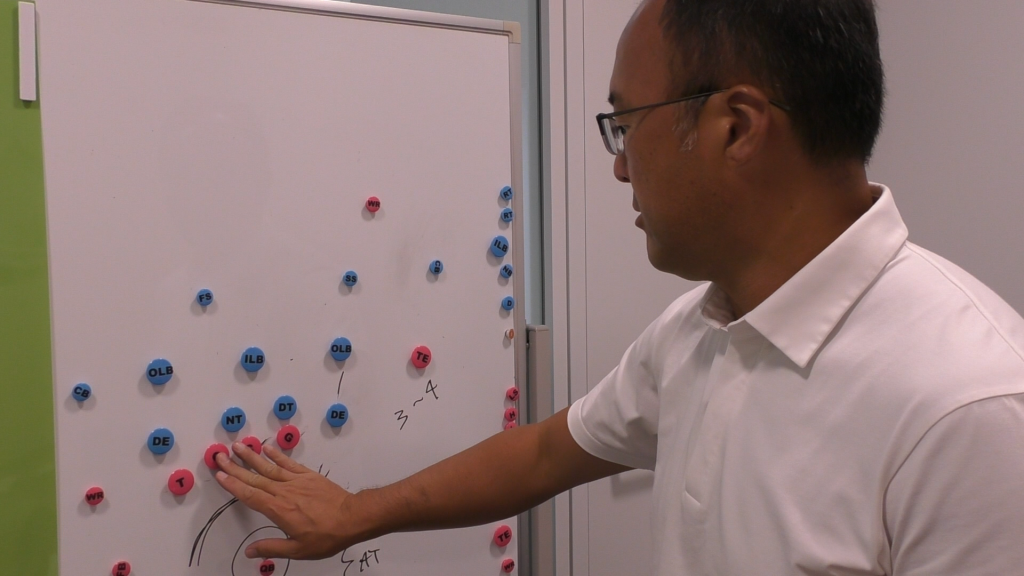
but Offense wants to take advantage and Defense wants to make big plays, and each game plan is set up in that way, so I think that is one of the most exciting aspects of Football.
Share this content:
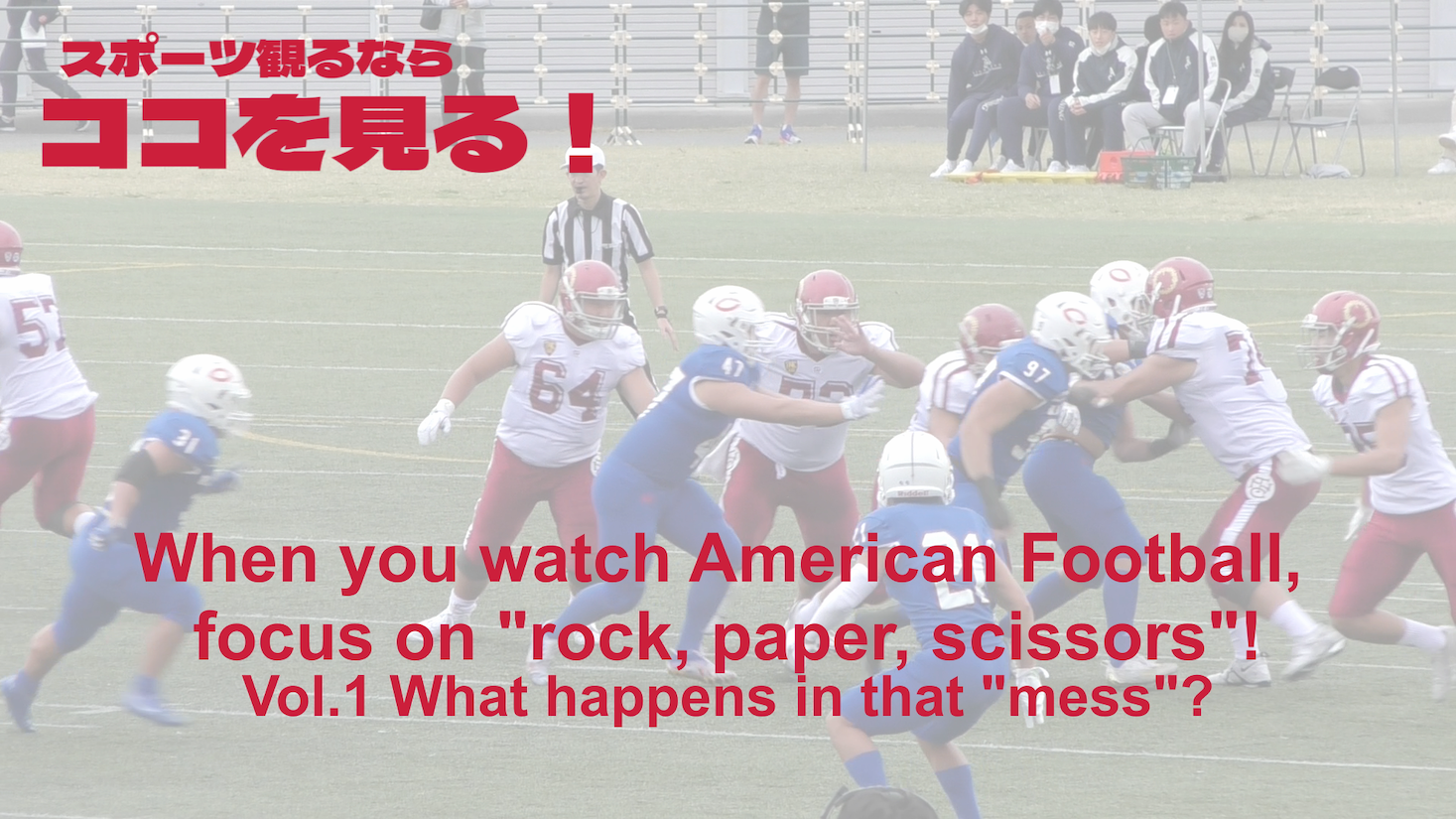
コメントを残す